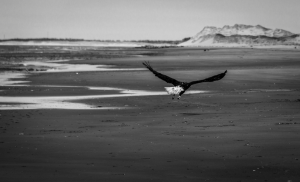Section 2 : Southern Door ~ Learning with Open Heart and Mind
Chapter 1: Welcome and Traditional Opening of Circle
The Beginning of Indigenous Teachings
I would like to extend a huge welcome to each and everyone of you as we enter into the beginning of Indigenous Teachings. As you may be aware if you’ve looked over the Course Syllabus, I have spend a significant portion of my years teaching both part-time and now full-time at the University of Prince Edward Island. In my full-time capacity, I not only teach an array of Indigenous courses including IKE 1040; but, I am also fulfilling a role as Coordinator and Curriculum Integrity for IKE 1040. There is a Cree word for this. It is Okanawiskwahtawin, which means ‘fire-keeper’ or guardian of something sacred, like fire for survival of the peoples, or, in this instance, the mandated UPEI course titled, Indigenous Teachings of Turtle Island, which is a concrete Truth and Reconciliation Commission’s Call to Action to educate our students about Indigenous and non-Indigenous peoples in Canada. You will learn much which I hope you may apply in your future careers and life.
I welcome you to the first chapter (corresponding as close as possible to the in-person class session) and the twelve chapters of this Open Education Resource. (OER) text. Herein, I highlight a significant amount of content that I deliver in the classroom; however, I use this text to also include other important information and links. I hope this resource will compliment your learning whether student, instructor or educational administrator. Let’s now begin by looking at the topics covered in this chapter.
Topics at a Glance
- Knowing, Being, and Doing as a Learning Process
- Traditional or Ceremonial Opening of the Circle
- Honouring the L’nu (Mi’kmaq) / Honour Song
- Sharing Circle
- UPEI’s Commitment / Faculty of Indigenous Knowledge, Education, Research, and Applied Studies / Minor in Indigenous Studies
Knowing, Being, and Doing as a Learning Process
Often times, in my past and present work, I have been given or take on a task to complete. It has always been a bit of a challenge when thinking about where to begin; but, on reflection it always begins with ‘knowing’. I cannot recall a time when I just ‘knew’ something. We may think we know something instinctively; but, we can always somehow trace it back to learning. So with a task before me, I always think about what I already know. Questions that usually surface include: have I done this before; can I apply what I know to this current task, and what else do I need to know before starting? More often than not, I conclude that I need to read, conduct further research, gather pertinent information or, in some cases, take a course.
In terms of a process, ‘knowing‘ is a central outcome in one’s journey of learning. We only begin to really know something after ‘learning’ about it whether it’s from textbooks, teachers or independent exploration. After spending time reflecting upon and understanding the topic, we then then work toward mastering this knowledge by applying it in some way. After feeling ‘masterful’, we often move to embracing this knowledge to the point of ‘being’ courageous and confident in its understanding. This may involve writing a paper, presenting in class, or taking an exam. It is then that we are ‘doing’ what needs to be done. This process also applies to identity and becoming that identity, let’s say being Indigenous. I had to learn Indigenous ways of knowing, being, and doing, to become that Indigenous person, not as a child; but much later in life. There is learning in all my Indigenous courses, not just for students; but, for me as well.
This course is learning about something new and not too familiar to most Canadians or anyone who has not been exposed to Indigenous peoples and their cultures to any great extent. Indigenous peoples comprise a rather small proportion of the Canadian population, and this may be one possible reason to account for this lack of information. We may also discover other reasons as well. Census data indicate that in 2021, five percent (5%) of the total Canadian population self-identify as being Indigenous (Statistics Canada, 2021). There are three main cultural groups that comprise Indigenous peoples in Canada, and they are legally recognized in Section 35(2) of the 1982 Canadian Constitution Act of Canada as the Indian (First Nations), Métis, and Inuit peoples. Approximately six percent of peoples globally identify as Indigenous (United Nations, 2024). I too am learning many facts, concepts, and teachings about Indigenous peoples as my trajectory of knowing about my own peoples’ (Cree peoples – Nehiyawak) history, culture, practices and ways only began two decades ago.
So I cannot say that I ‘know’ fully; but, I am learning. We are all constantly learning. This is a good thing and I like the fact that I am a student or learner (kiskinwahamâkan). I am currently enrolled in the PhD Educational Studies program at the University of Prince Edward Island, and eventually I will hopefully receive my doctorate; but, that still doesn’t mean I will fully know everything. So our Indigenous ways of knowing is to fully respect that knowing is learning through our ancestors, through our Elders, Knowledge Keepers, and teachers (okiskinohamâkew), and through self-discovery.
When I embrace our Indigenous ways of knowing, being, and doing, I am learning about our histories, cultures, ceremonies, beliefs and values, languages, traditions, protocols, and practices. I am learning to be a Cree person (nêhiyaw). The Cree peoples are one of the largest Indigenous groups in Canada. I am of mixed heritage, Finnish ancestry on my paternal side, and Cree on my maternal side. When I identify where I am from I trace my blood roots to St. Peters Reserve, Selkirk, Winnipeg, and include Peguis First Nation, Manitoba which is the First Nation community on my Indian status card. So in terms of learning, for me, and I hope for you, it becomes a very fulfilling journey when learning to honour this concept of knowing, being, and doing. There is a very specific term we us as Indigenous peoples to identify our worldview and teachings. It is commonly referred to Indigenous ways of knowing, being and doing, which will be discussed later. One teacher, Elder Mary Lee, whose work I often turn to especially in understanding Cree teachings including the Tipi Teachings, can be found at the Four Directions Website (Elder Mary Lee, Four Directions, 2012).
Traditional or Ceremonial Opening of the Circle
I always open my classes with a traditional or ceremonial opening. I first begin by creating a space that is welcoming, and into that space, I bring my sacred bundle, which contains all the necessary elements including the sacred medicines, medicine wheel alter, and eagle feather, to conduct a sacred welcoming and sharing ceremony. I try as best I can to create a circle, as Indigenous peoples see and do everything not in a linear or boxed fashion as contemporary Western classrooms are arranged; but in a circle as you see in Figure 1.
Figure 1: Opening Circle of Learning
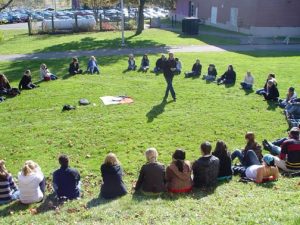
Once in the circle, we participate in a sacred smudging ceremony. The purpose of this sacred smudging, also known as a purification or cleansing ceremony, is best described by Mi’kmaq Elder Stephen Augustine, former Associate Vice President and Dean of Unama’ki College, Cape Breton University (Augustine, 2020). Before this ceremony commences I explain the general process. At times, I will read either the Mi’kmaq or Cree smudging prayer, which incorporates the teachings associated with the ceremony as I light the sacred medicines in a smudge bowl, cleanse myself and any helpers (oskâpêwis) with the sacred smoke that is created and fanned by an eagle feather, acknowledge the seven sacred directions (east, south, west, north, up, down, and within), and then smudge the alter, students, and classroom including windows and doorways. In this way, the space and people are cleansed, and all negative energies and troubling thoughts and anxieties are blended into the sacred smoke which rises and are taken away. Our collective prayers and new energies are safe to rise up, also lifted by the motions of the eagle feather, with the smoke created by our sacred medicines, and are taken to the Creator, Giver of Life. Through the power of prayer, we know that they will be heard and acted upon.
Honouring the L’nu
Before commencing a sharing circle and introducing ourselves, I always honour the ancestors and the peoples of this territory. The Mi’kmaq people are referred to as L’nu in their language. The traditional territory or district of the L’nu on Prince Edward Island and the North West part of Nova Scotia is known as Epekwitk aq Piktuk. To honour the L’nu, not only in this territory; but, in all their seven districts, I play the Honour Song written by George Paul from the district of Siknikt, which in present day is know as New Brunswick (Paul, 2013). It is like one’s national anthem and is explained quite well in the CBC article entitled, Meet the Mi’kmaw elder whose song has become an anthem for his people (Sweet, 2021). I cannot thank the Creator enough for this tremendous opportunity to be with the peoples of this territory, and to focus my work on Indigenous education at UPEI. Ceremony is how this journey began, and is best depicted in Figure 2, which is a photograph taken on September 28, 2021, which was the beginning of our Faculty as mentioned earlier in this text.
Figure 2: Honouring the Children and Survivors
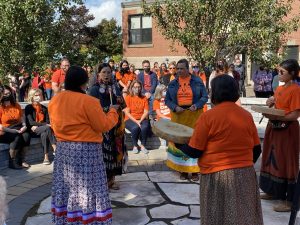
After prayer, while still very much in ceremony, I take the eagle feather, and pass it to each student so they may introduce themselves to others.
Sharing Circle
The sharing circle is an extremely important part of the opening as we, as Indigenous people, are highly relational. We honour the seasons, the water, the air, Mother Earth, all living things – the two-legged, the four legged, the fish, the birds, the insects, the trees and plants, all non-living things – the rocks, the mountains, the dust, sand and mud, our ancestors, our children, our Elders, our cultures, our peoples, our gifts, our strengths, our weaknesses, our path, the path of others, the teachings, the sacredness of life, the ways of our peoples, the mysteries, our resilience, our humour, the giving to others, and the belief in the Creator, the one who has given us so much and everything we need to live the life that has been bestowed upon us (Varis, 2015).
Given this relational foundation as a peoples, and the importance we place on relationality and its practice. It should not come as any surprise then, nothing begins before getting to know one another, and the sharing circle is the perfect forum to get to know one another. We take time to hear each other’s story, and honour this connectedness as ways to open new relations and pathways especially in this learning and self-discovery journey. I often use the sharing circle to explore different topics within class, each person sharing while they hold the sacred eagle feather as shown in Figure 3.
Figure 3: Students in Sharing Circle
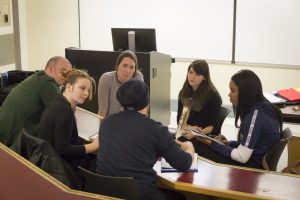
As I draw the ceremony of welcome and the introducing of each other to a close, I sometimes conclude with a prayer or special words. Most often, I turn to words from an Elder.
An Elder is a person who is highly respected for their wisdom, knowledge, and special skills. It is the community who determines who should be given that status, not the person themselves. There are also Knowledge Keepers, who are bestowed with great responsibilities to keep certain knowledges alive, safe and when the time is right to pass these on to others who will take them into the next generation. I often quote Elder and Ojibway writer, Richard Wagamese (see Figure 4). I will have much more to say about Elder Wagamese, who sadly passed to the spirit world in 2017, at other points in the textbook. I will quickly say however, that I had the great fortune to meet, dine with, and photograph Richard, who was on a book national tour and came to Charlottetown in 2014. In my mind, he is one of the greatest Indigenous writers and teachers of all time.
Figure 4: Richard at Confederation Centre of the Arts
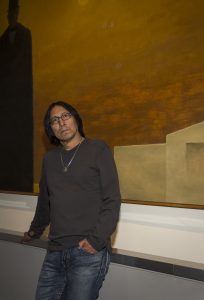
Wagamese writes,
“Respect is not something you earn. It’s not something you aspire to or ask of others. It isn’t your right or what you expect of people. Respect, in the Ojibway world, is the ability to honour all of Creation. It is something that you offer and something that you carry within you. The spiritual blessing of respect is harmony and the spiritual byproduct is community. When you choose to honour all Creation and, in turn, allow yourself to express it in your actions, you live respectfully, and because all things move in a circle, you will become respected. But it starts with the giving. It starts with the recognition that all things exist on the Sacred Breath of Creation and that because of that we are all related, all kin, all essential to on-going energy, the external heartbeat, the one song on the one drum that is the story of our time here. When you choose to allow yourself to carry respect for all your relations, you choose to allow yourself to honour Creation and allow yourself to live honourably. Once you accomplish that, your life itself will have become a ceremony – and that is the point of the Seven Grandfather Teachings” (Wagamese, 2019, p.181).
I always take a few minutes to give thanks to the Creator for the teachings that life gives us no matter how difficult it can be at times. Gratitude is a personal expression of respect for being alive and connected to all. This is the best time to take a pause to breathe and let gratitude comes full circle.
UPEI’s Commitment to Reconciliation / Faculty of Indigenous Knowledge, Education, Research, and Applied Studies / Minor in Indigenous Studies
The following section is something that I can speak directly to as I have been at the University of Prince Edward Island since 2002, and have been actively involved in Indigenous education since 2004. As sole Indigenous sessional lecturer for years, it was a relief when other Indigenous scholars started to arrive in 2015, and to usher in a new era of reconciliation. My journey will be subject to a more in-depth exploration in the next couple of years in conjunction with my PhD in Educational Studies program. I will simply say that the years following the release of the TRC Final Report and Calls to Action in December 2015 saw a lot of dialogue and discussion. Most Canadian post-secondary institutions present their commitments to reconciliation in high-level strategic plans. In 2023, Universities Canada released their commitments to truth and reconciliation, which focuses on 1) policies, strategic plans and governance; 2) Indigenous student success; 3) teaching and learning; 4) research; 5) community engagement; and 6) supporting people. This is an important step for all universities in Canada to be directly engaged in reconciliation education.
The UPEI commitment, released in 2018, reads as follows:
“UPEI is committed to advancing reconciliation through higher education. As a community, we have started a journey of growth to realize the role we must play in promoting an understanding of Indigenous history and culture, and supporting respectful relationships. UPEI recognizes that discussions in this era of truth and reconciliation will unveil difficult facts within our country’s history. However, in keeping with our institutional vision, we know that education is vital to understanding the history of colonialism and the forward looking process of reconciliation. Working together, we must use knowledge as a catalyst for meaningful change in communities here in Prince Edward Island and around our world” (UPEI Strategic Plan (2018-2023), p. 4).
It wasn’t until September 2021 that ‘things’ changed dramatically. You have already read about how the Creator intervened to say that the time of talking was over, and more concrete action was required. With the approval of a new Faculty of Indigenous Knowledge, Education, Research, and Applied Studies in November 2021, the time had come for a small core circle of Dr. Gary Evans (Interim Dean), Dr. and Elder Judith Clark (Elder-in-Residence and Faculty Elder, Corinne Chappell (Advisor to Vice President, Academic and Research on Indigenous Affairs, and myself (appointed to Assistant Professor in July 2022) to enact all that was required to stand-up the Faculty (see article in NationTalk, 2022 for an overview of development). I invite you to the Faculty Webpage where our foundational work resides (IKERAS, 2024). The site highlights the following: 1) IKERAS Mission Statement; 2) IKERAS Values; 3) Elders and Scholars; 4) News and Events; 5) Seven Sacred Teachings; and 6) Minor in Indigenous Studies.
The Minor in Indigenous Studies page describes the course requirements, and gives an overview of the structure including mandatory as well as elective courses. As of January 1, 2024, only 16 months after the launch of IKERAS’ full academic year, about 30 students have declared a minor in Indigenous studies. This is an exceptionally positive beginning for Indigenous Teachings, reconciliation, and responsible citizenship at the University of Prince Edward Island.
Key Terms and Concepts from Session
- Knowing, Being, and Doing as a Learning Process
- Indigenous peoples in Canada / Indian (First Nations), Métis, and Inuit
- Indigenous ways of knowing, being and doing
- Traditional or Ceremonial Opening
- L’nu (Mi’kmaq)
- Sacred Smudging Ceremony
- Prayer / Sacred Medicines / Eagle Feather
- Sharing Circle
- Relational and relationality
- Elders / Knowledge Keepers
- Reconciliation
- Faculty of Indigenous Knowledge, Education, Research and Applied Studies
Important Readings / Viewings for Next Class
- Please read and view all of the material in the chapter if you haven’t already. For linked material, be aware of these important sources of information. If something intrigues you or catches your attention, please gather that ‘knowledge’ by exploring and taking a pathway to additional learning.
- Please read the following: The Haudenosaunee Creation Story
- Please read the following: The Creation Story
Special Topics
Cultural Competency Tutorials
Meaning of the Eagle Feather in Mi’kmaq Culture | Aaron Prosper
